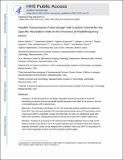| dc.contributor.author | Schiavi, Emanuele | |
| dc.contributor.author | Eryaman, Yigitcan | |
| dc.contributor.author | Herraiz, Joaquin L. | |
| dc.contributor.author | Gagoski, Borjan | |
| dc.contributor.author | Guerin, Bastien | |
| dc.contributor.author | Martin Fernandez, Adrian | |
| dc.contributor.author | Adalsteinsson, Elfar | |
| dc.contributor.author | Wald, Lawrence | |
| dc.date.accessioned | 2017-07-18T15:33:30Z | |
| dc.date.available | 2017-07-18T15:33:30Z | |
| dc.date.issued | 2016-05 | |
| dc.date.submitted | 2015-05 | |
| dc.identifier.issn | 0740-3194 | |
| dc.identifier.issn | 1522-2594 | |
| dc.identifier.uri | http://hdl.handle.net/1721.1/110757 | |
| dc.description.abstract | Purpose
A new framework for the design of parallel transmit (pTx) pulses is presented introducing constraints for local and global specific absorption rate (SAR) in the presence of errors in the radiofrequency (RF) transmit chain.
Methods
The first step is the design of a pTx RF pulse with explicit constraints for global and local SAR. Then, the worst possible SAR associated with that pulse due to RF transmission errors (“worst-case SAR”) is calculated. Finally, this information is used to re-calculate the pulse with lower SAR constraints, iterating this procedure until its worst-case SAR is within safety limits.
Results
Analysis of an actual pTx RF transmit chain revealed amplitude errors as high as 8% (20%) and phase errors above 3° (15°) for spokes (spiral) pulses. Simulations show that using the proposed framework, pulses can be designed with controlled “worst-case SAR” in the presence of errors of this magnitude at minor cost of the excitation profile quality.
Conclusion
Our worst-case SAR-constrained pTx design strategy yields pulses with local and global SAR within the safety limits even in the presence of RF transmission errors. This strategy is a natural way to incorporate SAR safety factors in the design of pTx pulses. | en_US |
| dc.description.sponsorship | National Institutes of Health (U.S.) (R01EB006847) | en_US |
| dc.language.iso | en_US | |
| dc.publisher | Wiley Blackwell | en_US |
| dc.relation.isversionof | http://dx.doi.org/10.1002/mrm.25820 | en_US |
| dc.rights | Creative Commons Attribution-Noncommercial-Share Alike | en_US |
| dc.rights.uri | http://creativecommons.org/licenses/by-nc-sa/4.0/ | en_US |
| dc.source | PMC | en_US |
| dc.title | Parallel transmission pulse design with explicit control for the specific absorption rate in the presence of radiofrequency errors | en_US |
| dc.type | Article | en_US |
| dc.identifier.citation | Martin, Adrian; Schiavi, Emanuele; Eryaman, Yigitcan et al. “Parallel Transmission Pulse Design with Explicit Control for the Specific Absorption Rate in the Presence of Radiofrequency Errors.” Magnetic Resonance in Medicine 75, 6 (July 2015): 2493–2504. © 2015 Wiley Periodicals, Inc | en_US |
| dc.contributor.department | Institute for Medical Engineering and Science | en_US |
| dc.contributor.department | Harvard University--MIT Division of Health Sciences and Technology | en_US |
| dc.contributor.department | Massachusetts Institute of Technology. Department of Electrical Engineering and Computer Science | en_US |
| dc.contributor.mitauthor | Martin Fernandez, Adrian | |
| dc.contributor.mitauthor | Adalsteinsson, Elfar | |
| dc.contributor.mitauthor | Wald, Lawrence | |
| dc.relation.journal | Magnetic Resonance in Medicine | en_US |
| dc.eprint.version | Author's final manuscript | en_US |
| dc.type.uri | http://purl.org/eprint/type/JournalArticle | en_US |
| eprint.status | http://purl.org/eprint/status/PeerReviewed | en_US |
| dspace.orderedauthors | Martin, Adrian; Schiavi, Emanuele; Eryaman, Yigitcan; Herraiz, Joaquin L.; Gagoski, Borjan; Adalsteinsson, Elfar; Wald, Lawrence L.; Guerin, Bastien | en_US |
| dspace.embargo.terms | N | en_US |
| dc.identifier.orcid | https://orcid.org/0000-0002-7637-2914 | |
| mit.license | OPEN_ACCESS_POLICY | en_US |
